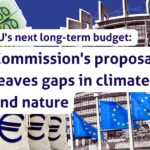Introduction
EU and Member State climate action remain off track with the international Paris Agreement commitments to prevent dangerous climate change and limit temperature increase to 1.5°C. Nonetheless, recent decisions on EU climate targets – climate neutrality by 2050 and reducing net emissions by at least -55% by 2030 – are inducing a substantial revision of the policy tools needed to achieve these new targets.
The upcoming general revision of the EU’s climate and energy policy framework offers a unique possibility to ramp up climate action across all economic sectors and to fully align EU policy with its global commitments. While the amount of policies influencing EU climate action is vast, this paper specifically deals with the three pillars of the more ‘traditional’ climate policy architecture (ETS Directive, ESR Regulation and LULUCF Regulation) and in particular on how they relate to each other and to the overall climate targets and commitments. A more comprehensive set of recommendations, also looking at integrating climate concerns in horizontal policies beyond climate and energy can be found in CAN Europe’s Climate Urgency Plan[1] for the EU. Furthermore, other more specific position papers will deal with specific elements of these and other relevant policies.[2]
Urgent action is vital in the short term to reduce emissions and increase nature based removals while preserving biodiversity. A clear and ambitious long term pathway towards and beyond net-zero emissions will be needed to address the climate emergency and align policies with the 1.5°C target of the Paris Agreement. It will be crucial that this pathway supports a socially just transformation towards a climate safe society, in line with CAN Europe’s Just Transition position paper. [3]
In light of this increase of ambition, this position paper sets out targets and principles for the necessary updated EU climate policy architecture, and in particular, the relationship between the three key climate files that will be revised in 2021, namely the EU Emissions Trading System (ETS), the Effort Sharing Regulation (ESR) and the Land Use, Land Use Change and Forestry (LULUCF) Regulation.
Ensure the EU contributes its fair share by increasing ambition
Based on the latest available science, and in line with the equity principles of the UN Framework Convention on Climate Change the EU must recognise its historical responsibility and greater capacity to act. Therefore the EU needs to both substantially reduce its greenhouse gas emissions, as well as provide climate finance and other forms of support to climate action in developing countries. Furthermore, the EU’s emission reduction target needs to cover emissions from all sectors and needs to be combined with a specific target for net removals from nature based activities.
|
CAN Europe calls for the EU to:
|
Keep road transport, buildings and agriculture emissions in the effort sharing regulation
Some of the options analysed by the European Commission envisage a shift of sectoral emissions currently covered by the ESR to be covered by the EU Emissions Trading System (road transport and buildings) or by the Land Use Regulation (agriculture). While carbon pricing is essential to ensure the Polluter Pays Principle, it is insufficient to address key non-market barriers to deploying clean energy solutions at scale in the transport and building sectors. A dedicated policy framework will always be needed for these sectors. Furthermore, the road transport and buildings sectors have significantly higher levels of abatement costs and show overall lower price elasticities, therefore including them in a single EU ETS would risk shifting pressure away from these new sectors. Unless embedded in a broader policy framework, inclusion in the ETS could be socially regressive and undermine citizen support for more effective climate policy. Including road transport and buildings into the ETS could distract attention away from other EU regulatory instruments (energy labelling, CO2 standards, …) with substantial decarbonisation potential. The removals in the LULUCF sector must not be used to offset lack of action in other sectors. Emissions from agriculture must be tackled locally and remain national responsibility. The required structural and behaviour changes should be governed and incentivised at national level, under the scope of the ESR, while relevant EU policy, such as relevant EU funds and the Common Agricultural Policy (CAP) should be made fully consistent with the EU’s international climate commitments.
|
CAN Europe calls for the EU to:
|
Maintain and substantially increase nationally binding targets
Although current nationally binding targets under the Effort Sharing Regulation are not ambitious enough to drive down emissions in non-ETS sectors at a rate and speed needed to be compatible with the Paris Agreement, they are still an indispensable regulatory tool to ensure Member State accountability for their domestic efforts to tackle climate change. Any option to remove or weaken nationally binding targets or reduce their scope would severely damage the overall integrity of the EU’s 2030 climate policy architecture as there is a risk that Member States will no longer take responsibility for achieving emission reductions in these sectors.
|
CAN Europe calls for the EU to:
|
Substantially increase emission reduction targets for both ETS and ERS sectors
In order to honour the Paris Agreement and achieve the EU’s fair share, it will be important to set the highest possible targets for both the ETS and ESR legislation, thereby also giving meaning to the “at least” prefix before the economy-wide EU climate target. The targets for both the ETS and non-ETS sectors need to reflect the highest ambition possible and need to drive much more substantial emission reductions in the non-ETS sectors, while ensuring strong emission reductions can continue in the ETS sectors where also substantially increased efforts are needed in the industry sector. Furthermore, it is not only the end date target that matters, but strong action is also needed to ensure the total allowed emissions under both the ETS and ESR legislation are limited.
|
CAN Europe calls for the EU to:
|
Enhancement of natural sinks separately and additionally to emission reductions target
The Commission has proposed to turn the overall EU 2030 climate target into a net target, which would include carbon removals by sinks. This severely risks watering down the target for actual emission reductions to 52.8%, depending on the development of EU sink capacity until 2030, and it suggests a trade-off between mitigation and sink enhancement which are both indispensable and require dedicated action. At the same time, sinks may not be permanent (problem of non-permanence) and can therefore not function as a substitute for actual emission reductions. The Commission is preparing the introduction of a Nature Restoration target. This target should become a main driver for the protection, restoration and enhancement of natural sinks throughout Europe.
|
CAN Europe calls for the EU to:
|
More robust governance systems
In order to underpin the achievement of these increased efforts, governance mechanisms at the EU and national level should be enhanced and further streamlined in order to ensure effective verification and accounting of emissions and robust and transparent monitoring and reporting of progress. In particular, there should be no flexibility to use credits from LULUCF to undermine the targets set for either ESR or ETS. Furthermore, the Governance regulation should be strengthened in order to effectively drive the EU’s full and irreversible economic decarbonisation.
|
CAN Europe calls on the EU to:
|
[1] CAN Europe Climate Urgency Plan for the EU.
[2] An overview of CAN Europe’s position papers can be found HERE.
[3] CAN Europe Position Paper on Just Transition.



